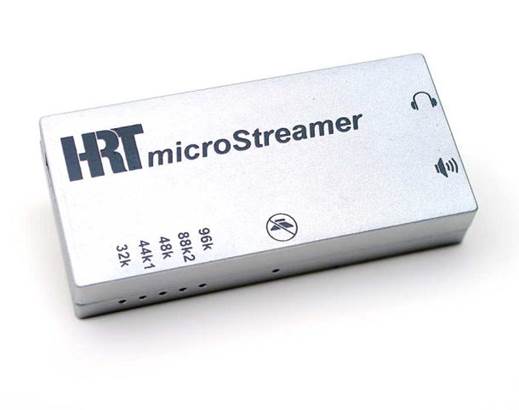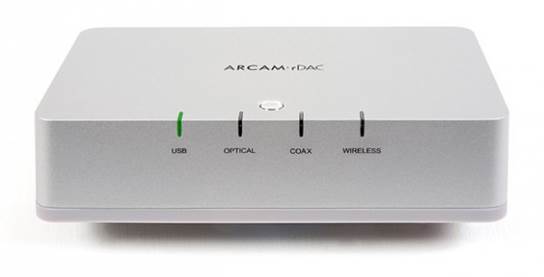The winners
USB-compatible DACs are entering the
mainstream, and our two winners – one portable and one static are the vanguard
of an impressive new wave
- HRT micro-Streamer: $360; Ratings 5/5
- Arcam rDAC: $519; Ratings 5/5
If you were ever in any doubt about whether
or not computer audio could attain the heights of hi-fi, worry no more. As
computer-based music grows in strength and popularity, DACs (and especially
DACs with a USB connection) are increasingly coming out of their niche market
and enticing music lovers everywhere with their talents.
The nine DACs we gathered for this Super
test come in all sizes and shapes and features, with only one common criterion:
a USB connection. We have four mains-powered DACs from Arcam, Lindy, Micromega
and Musical Fidelity that demand a place on your shelf or desk, while the
remaining five from Arcam, Audio quest, HRT, Furutech, and Meridian are
USB-powered and truly portable.

HRT
micro-Streamer: $360 is one of the winners
Spoilt for choice
We felt a bit like a child in a sweetshop
with all these DACs at our fingertips. In fact, this is the first (and will
possibly be the only) time that we’ve been able to carry the entire contents of
a Super test in just two hands. And, at prices ranging from $254 to $631, these
DACs are surely a must-have hi-fi staple for anyone with a digital music
library.
So, to the larger contenders first.
Crossing the big money threshold were the Lindy LDAC-Pro and the Furutech ADL
Stride, the two most expensive DACs in this test, but price isn’t always
indicative of sound performance. While the Lindy is decked out with more
features than you could shake an iPod at, it disappointed with an unexceptional
sound that seemed to have little interest in the music it was playing. The
Furutech usefully has a line-level input to use with smart devices, but it
doesn’t have the dynamic punch or detail of its more capable rivals.
In four-star territory we’ve got the sweet
and midrange-rich sound of the Musical Fidelity V-DAC II sitting next to the
exuberant attacking style of the new Micromega MyDAC.
Both these devices are impressively good at
what they do, but neither has the all-round performance of the Arcam rDAC. A
2011 Award-winner, this unit has remained a firm favorite at What Hi Fi? Thanks
to its splendid dynamics and engaging level of detail – it just keeps the
listener hooked on the music playing. It was easy to pick the Arcam rDAC as our
first winner in the DAC Super test: if you’ve got over $360 to spend on a
standalone DAC that bridges the gap between your computer and your stereo
system, the rDAC is the ideal option.

It
was easy to pick the Arcam rDAC as our first winner in the DAC Super test: if
you’ve got over $360 to spend on a standalone DAC that bridge the gap between
your computer and your stereo system
It wasn’t that straightforward when it came
to our second winner. The emergence of neatly designed, great-sounding
pocket-sized USB DACs has really upset the apple cart. The Arcam rPAC was the
best portable option before this new breed of petite DACs came along in the
last one year or so, and it’s still in the game with a friendly sound
reminiscent of the rDAC, and even friendlier price tag of $254, but it’s just
short of the insightful and weighty performance found in some of its class
rivals.
DACs are enticing music lovers
everywhere and, at prices ranging from $254 to $631, these ones are surely soon
to be a must-have hi-fi staple for anyone with a digital music library
The biggest surprise concerned the
Award-winning Audio quest DragonFly: its sleek design and color-changing logo
still has a moth-to-flame attraction, but the subtle dynamics and insightful
detail of the HRT micro-Streamer and the Meridian Explorer super ceded it and
lost it a precious star.

The
biggest surprise concerned the Award-winning Audio quest DragonFly
Those two contenders easily merited five
stars, but of the two it was the unassuming HRT micro-Streamer that truly
captivated us with a stunningly agile-paced performance that reveals layers of
subtlety hitherto unheard with a just a simple pair of headphones and laptop.
Factor in its $360 price tag and it was a no-brainer from the word go: the
micro-Streamer is the perfect option for a brilliant portable system that’ll
keep your music sounding nothing short of superb all the time.
Before you buy
File resolution
It’s easy to get hung up on specification.
Many of the DACs in this test top out at 24-bit/96kHz through USB rather than
delivering the full 24-bit/192kHz. How important this is depends on the music
files you use. If you buy from iTunes or at best rip uncompressed from CDs then
that lower 96 kHz limit is still far beyond what you’ll need. But if you’re
dedicated to the highest-resolution recordings, make sure your DAC will cope.